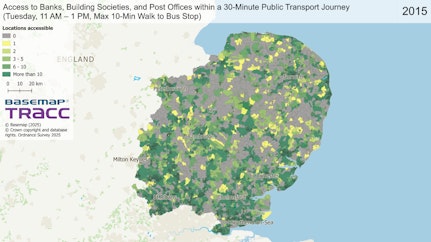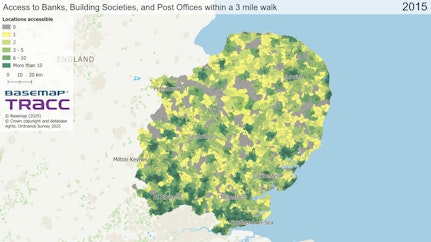



Access to bank branches has been declining rapidly over the last decade, with Which.co.uk stating that 6266 bank branches have closed since January 2015. With online banking becoming more common and less people going into a branch, banks have decided to close branches, with many areas being left without access. Though many are turning to online banking, there are still some people and small businesses which rely on their local banks, particularly in rural areas with poor broadband and mobile coverage and typically an older population.
To protect access to banking services, banking hubs have been introduced. These hubs allow people to make deposits and withdrawals and pay bills as well as services such as community bankers and private spaces for more inquiries. In addition to banking hubs, there has been an increase in the banking services available at post offices including deposits and withdrawals and checking your balance. However, these locations lack bank services such as advice regarding bank accounts, mortgages or loans.
In 2023, the Financial Services and Markets Act 2023 was put in place to ensure access to cash for those who need it. This followed laws to facilitate cashback without a purchase in 2021 to provide an additional way for people to access cash. In 2023, the Financial Conduct Authority published analysis on the access to cash for the second quarter of 2022. This analysis estimated that 96.2% of the UK population were within 2km of a free-to-use cash access point and 99.8% within 5km. This analysis was based on straight line distances from residential addresses to their nearest cash access point.
Following the announcement in January 2025 that Lloyds Banking Group planned to close 136 branches in 2025, on top of 102 closures which had already been announced, we decided to analyse how access to bank branches had changed since 2015. To do this, we used bank and post office location data from DataCutter and cut this down to the locations within Eastern England. For the locations for 2025, we also removed any branches that have been publicised to close during 2025.
TRACC was then used to analyse both walking and public transport access from each population weighted output area centroid in Eastern England to bank branches or post offices within a 3-mile walk or a 30-minute public transport journey (Tuesday 11am-1pm). This used road data from OS OpenRoads and public transport data for Q4 of 2015 and Q1 of 2025 from DataCutter. Public transport journeys allowed for an 800m walk to the first public transport stop and 400m between interchanges.
In 2015, there were 1110 bank branches within Eastern England meaning 84% of output areas could access a bank within a 3 mile walk and 88% being able to access a branch within a 30-minute public transport journey. Whilst there were a similar number of post office locations (1068) accessibility to these locations was slightly higher with 98% of output areas having walking access and 86% having access by public transport. Overall, 98.4% of the population were able to access a bank or post office within a 3-mile walk and 92.4% within a 30-minute public transport journey. However, when taking into account only access to bank branches, 48% of residents in rural areas were within a 3-mile walk and 68% within a 30-minute public transport journey.
In 2025, the number of bank branches has decreased by over 40%, down to 694 locations. This has led to a drop to 79% of output areas with walking access and 85% with public transport access to a bank. This is in clear comparison to post offices which have increased to 1163 locations, though with little change to the proportion of output areas with access. Six banking hubs are also now open within Eastern England to help provide banking services where bank branches have been lost. Overall, 98.1% off the population were able to access a bank or post office within a 3-mile walk and 92.5% within a 30-minute public transport journey. When taking into account solely bank access, only 36% of rural residents can access a bank within a 3-mile walk and 61% within a 30-minute public transport journey.

On average, people are able to access 3 less locations within a 3-mile walk and 5 less locations within a 30-minute public transport journey in 2025 compared to 2015.
Southend-on-Sea has been hit the hardest with an average loss of 6 locations accessible by walking and 8.6 by public transport. In 2015, approximately 98,500 residents did not have access to a bank or post office with a 3 mile walk, increasing to 115,700 residents in 2025.
Rural areas have been particularly affected, with 12% of rural residents who could previously access a bank no longer able to access a bank within a 3-mile walk compared to 3% of urban residents.
Whilst most areas still have access to a bank, it may not be the bank that they use. Barclays is the most common branch in Eastern England, with 226 branches in 2015, however this almost halved to 125 branches in 2025. This drop in number of locations has led to Barclays no longer being the most accessible branch in Bedford, Cambridgeshire, Southend-on-Sea or Suffolk in 2025.
Branches such as Royal Bank of Scotland have seen a sharp decrease in locations - in the case of RBS a drop from 22 to 2 branches – due to banking groups having multiple branches in one town. For example, Natwest Group now allows Royal Bank of Scotland customers to bank in Natwest branches and therefore closed many branches in England and Wales.
However, it is worth noting that access to particular bank branches has increased, with an additional 15 Yorkshire Building Society branches and 10 additional Metro Bank branches.
From this analysis it is clear that access to banks has reduced greatly over the last decade. Whilst post offices and banking hubs help to improve accessibility to certain banking services, many are left without access to bank specific services such as mortgage advice or have a smaller number of banks to choose from. Recent news suggests that some major banks may be set to remove the option of cashing cheques at customers' local Post Office. Rural areas in particular are greatly affected with a higher likelihood of being impacted by poorer mobile signal and an older population making digital banking less suitable as an alternative.
With banks such as Nationwide promising to not close existing branches until 2028, it is clear that banks understand the importance of in-person banking. That said, with more banks closing each month we can expect to see more areas losing access over the next few years. Tools such as TRACC can be used to identify areas which are losing bank access in order to inform the locations of banking hubs, community pop-ups and mobile branches.